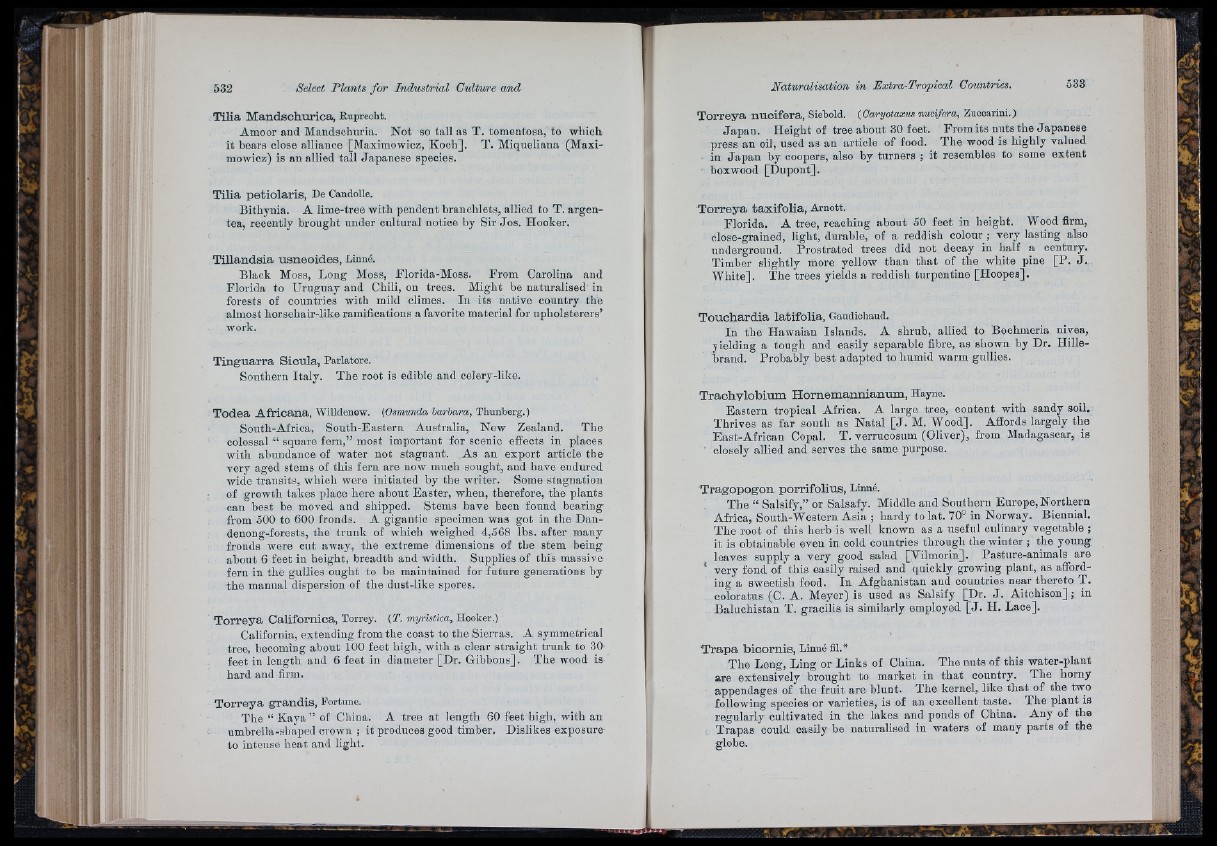
Tilia Mandschurica, Euprecht.
Amoor and Mandsohnria. Not so tall as T. tomentosa, to which
it bears close alliance [Maximowicz, Kooli]. T. Miqueliana (Maxi-
mowicz) is an allied tall Japanese species.
Tiha petiolaris, De Candolle.
Bithynia. A lime-tree with pendent branchlets, allied to T. argentea,
recently brought under cultural notice by Sir Jos. Hooker.
Tillandsia usneoides, Linné.
Black Moss, Long Moss, Florida-Moss. From Carolina and
Florida to Uruguay and Chili, on trees. Might be naturalised in
forests of countries with mild climes. In its native country the
almost horsehair-like ramifications a favorite material for upholsterers’
work.
Tinguarra Sicula, Parlatore.
Southern Italy. The root is edible and celery-like.
Todea Africana, Willdenow. (Osmunda barhara, Thunberg.)
South-Africa, South-Eastern Australia, New Zealand. The
colossal “ square fern,” most important for scenic effects in places
with abundance of water not stagnant. As an export article the
very aged stems of this fern are now much sought, and have endured
wide transits, which were initiated by the writer. Some stagnation
of growth takes place here about Easter, when, therefore, the plants
can best be moved and shipped. Stems have been found bearing
from 500 to 600 fronds. A gigantic specimen was got in the Dan-
denong-forests, the trunk of which weighed 4,568 lbs. after many
fronds were cut away, the extreme dimensions of the stem being
about 6 feet in height, breadth and width. Supplies of this massive
fern in the gullies ought to be maintained for future generations by
th e manual dispersion of the dust-like spores.
Torreya Californica, Torrey. (T. myristica, Hooker.)
California, extending from the coast to the Sierras. A symmetrical
tree, becoming about 100 feet high, with a clear straight trunk to 30
feet in length and 6 feet in diameter [Dr. Gibbons], The wood is
hard and firm.
Torreya grandis, Fortune.
The “ Kaya ” of Cliina. A tree at length 60 feet high, with an
umbrella-shaped crown ; it produces good timber. Dislikes exposure-
to intense heat and hglit.
Torreya nucifera, Siebold. {Garyotaxus nucifera, Zuccarini.)
Jap an . Height of tree about 30 feet. From its nuts the Japanese
press an oil, used as an article of food. The wood is highly valued
in J ap a n by coopers, also by turners ; it resembles to some extent
boxwood [Dupont].
Torreya taxifolia, Arnott.
Florida. A tree, reaching about 50 feet in height. Wood firm,
close-grained, light, durable, of a reddish colour ; very lasting also
underground. Prostrated trees did not decay in half a century.
Timber slightly more yellow than th a t of the white pine [P . J .
White]. The trees yields a reddish turpentine [Hoopes].
Touchardia latifolia, Gaudichaud.
In the Hawaian Islands. A shrub, allied to Boehmeria nivea,
yielding a tough and easily separable fibre, as shown by Dr. Hillebrand.
Probably best adapted to humid warm gullies.
Trachylobium Hornemannianum, Hayne.
Eastern tropical Africa. A large tree, content with sandy soil.
Thrives as far south as Natal [ J . M. Wood]. Affords largely the
East-African Copal. T. verrucosum (Oliver), from Madagascar, is
closely allied and serves the same purpose.
Tragopogón porrifolius, Linné.
The “ Salsify,” or Salsafy. Middle and Southern Europe, Northern
Africa, South-Western Asia ; hardy to lat. 70° in Norway. Biennial.
The root of this herb is well known as a useful culinary vegetable ;
it is obtainable even in cold countries through the w inter ; the young
leaves supply a very good salad [Vilmorin]. Pasture-animals are
‘ very fond of this easily raised and quickly growing plant, as affording
a sweetish food. In Afghanistan and countries near thereto T.
coloratus (C. A. Meyer) is used as Salsify [Dr. J . Aitchison] ; in
Baluchistan T. gracilis is similarly employed [ J . H. Lace].
Trapa bicornis, Linné fil.*
The Long, Ling or Links of China. The nuts of this water-plant
are extensively brought to market in th a t country. The horny
appendages of the fruit are blunt. The kernel, like th a t of the two
following species or varieties, is of an excellent taste. The plant is
regularly cultivated in the lakes and ponds of China. Any of the
Trapas could easily he naturalised in waters of many parts of the
globe.